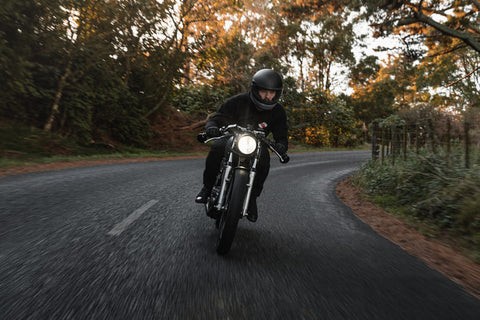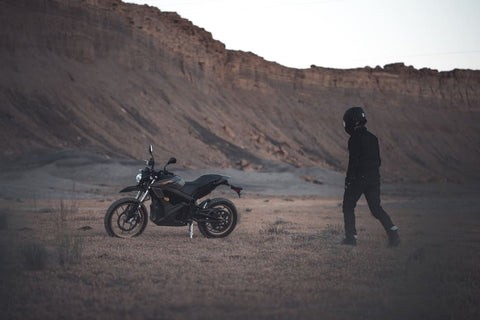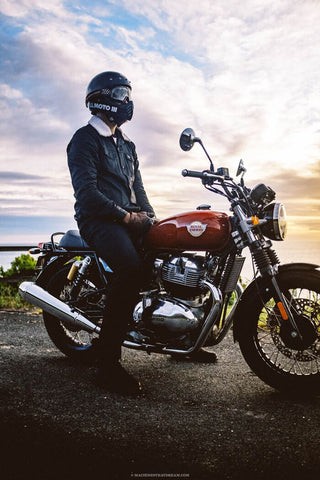Learning how hard it is to learn to ride a motorcycle is a question many aspiring riders ask. At LEARNS.EDU.VN, we believe that with the right approach, anyone can master the art of motorcycle riding, gaining not just a skill but also a sense of freedom and adventure. We will explore the challenges and rewards of becoming a motorcyclist.
1. Who Can Learn to Ride a Motorcycle?
The fantastic thing about motorcycling is its accessibility. It’s not just for the physically fit or those with a certain build. Motorcycles come in various shapes and sizes, ensuring there’s a fit for almost everyone. According to the Motorcycle Industry Council, more and more people are taking up motorcycle riding, with a significant increase in female riders, showing that motorcycling is truly for everyone.
| Factor | Consideration |
|---|---|
| Physicality | While some strength helps, technique and leverage are more critical. |
| Height/Weight | Bikes vary in size; finding one that fits your proportions is key. |
| Mental State | A calm, focused mind is crucial. Fear is normal, but excessive anxiety can be detrimental. |
| Coordination | Basic coordination helps, but specific skills develop with practice. |




Alt text: A motorcyclist enjoys a scenic ride on a winding road surrounded by lush trees, demonstrating the freedom of motorcycle riding.
2. Is Riding a Motorcycle Hard? A Step-by-Step Guide
Learning to ride a motorcycle involves mastering several key skills. Let’s break down the process into manageable steps:
2.1 Choose the Right Motorcycle
Selecting the right motorcycle is crucial for beginners. A bike under 600cc is generally recommended because it’s easier to handle. Lighter bikes are more forgiving and allow you to focus on mastering the basics. Comfort is key; you should feel relaxed and in control, not cramped or stretched out.
- Engine Size: Start with a smaller engine (under 600cc).
- Weight: Opt for a lighter bike for easier handling.
- Seat Height: Ensure you can comfortably reach the ground with both feet.
- Riding Position: Choose a bike with an upright riding position for better control.
2.2 Pre-Check the Bike
Before each ride, conduct a quick inspection to ensure your bike is safe. This includes checking fluid levels, brakes, throttle, clutch, tires, and mirrors. Regular maintenance can prevent unexpected issues and ensure a safer riding experience.
- Fluid Levels: Check oil, coolant, and brake fluid.
- Brakes: Ensure levers and pedals are responsive.
- Throttle & Clutch: Verify smooth operation.
- Tires: Check pressure and tread depth.
- Mirrors: Adjust for optimal visibility.
2.3 Pick the Appropriate Motorcycle Gear
Safety gear is non-negotiable. Always wear a helmet, jacket, gloves, pants, and boots. Proper gear can significantly reduce the risk of injury in case of an accident. Acronym to remember: ATGATT (All The Gear, All The Time).
- Helmet: DOT, ECE, or Snell approved.
- Jacket: Abrasion-resistant with armor.
- Gloves: Full-fingered with knuckle protection.
- Pants: Reinforced denim or riding pants with armor.
- Boots: Over-the-ankle with sturdy soles.
2.4 Know Your Brakes
Motorcycles have separate front and rear brakes. The front brake, controlled by the lever on the right handlebar, provides about 70% of your stopping power. The rear brake is operated by a pedal on the right side. Practice using both brakes smoothly to avoid jerking or losing balance.
- Front Brake: Right handlebar lever.
- Rear Brake: Right foot pedal.
- Technique: Apply both brakes smoothly and evenly.
- Practice: Get a feel for the brakes in a controlled environment.
2.5 Learn Proper Control of Clutch and Throttle
The throttle controls the engine’s power, and the clutch engages and disengages the engine from the transmission. Mastering the coordination between these two is essential for smooth starts and gear changes.
- Throttle: Controls engine power; use gently.
- Clutch: Engages/disengages the engine; squeeze smoothly.
- Coordination: Practice smooth starts and gear changes.
- Gears: Understand the gear order and how to shift.
2.6 Exercise Balancing and Turning
Motorcycles respond to your body movements. Leaning into turns is crucial for maintaining balance and control. Practice in a safe, open area to get comfortable with these movements.
- Body Movement: Stay aligned with the bike’s movements.
- Leaning: Lean into turns to maintain balance.
- Practice: Start with slow, wide turns in a safe area.
2.7 Practice
Consistent practice is the key to mastering motorcycle riding. Start in a controlled environment and gradually progress to more challenging situations. The more you ride, the more natural these skills will become.
- Consistency: Practice regularly to build muscle memory.
- Progression: Gradually increase the difficulty of your practice sessions.
- Patience: Be patient with yourself and celebrate small victories.
| Step | Description | Time Allotment (Approximate) |
|---|---|---|
| Choosing the Right Bike | Research different models, consider engine size and weight, and test ride if possible. | 1-2 weeks |
| Pre-Ride Check | Develop a checklist and practice inspecting your bike before each ride. | Ongoing (5-10 minutes) |
| Gear Selection | Invest in quality gear that fits properly and provides adequate protection. | 1-2 days |
| Braking Technique | Practice applying both front and rear brakes smoothly in a controlled environment. | 1-2 hours |
| Clutch and Throttle Control | Practice starting, stopping, and shifting gears smoothly. | 2-3 hours |
| Balancing and Turning | Start with slow-speed maneuvers in a large, empty parking lot. | 2-3 hours |
| Consistent Practice | Ride regularly to reinforce skills and build confidence. | Ongoing |
Alt text: A motorcyclist confidently strides toward their motorcycle, highlighting the anticipation and excitement of riding.
3. Essential Reminders for Beginner Riders
3.1 The Importance of Motorcycle Insurance, License, and Registration
Ensure you have the necessary legal documentation before hitting the road. Motorcycle insurance is compulsory in many places. The policy you get will depend on factors like your age, gender, the bike you ride, and how often you use it.
- Insurance: Obtain adequate coverage for your bike.
- License: Ensure you have a valid motorcycle license.
- Registration: Register your bike with the relevant authorities.
3.2 Don’t Take Passengers Until You Can
Resist the urge to give rides to friends until you’re confident in your abilities. Carrying a passenger adds complexity and risk to your ride.
- Experience: Gain sufficient experience riding solo before carrying passengers.
- Safety: Prioritize the safety of yourself and your passenger.
3.3 Stay Away from the Highways for Now
Avoid highways until you’re comfortable with shifting gears and changing lanes. High-speed traffic can be overwhelming for new riders.
- Confidence: Build confidence on quieter roads first.
- Skills: Master basic skills before tackling high-speed environments.
3.4 Be Aware of the Weather
Weather conditions significantly impact motorcycle riding. Rain reduces traction and visibility. Drive slowly, take turns with ease, and brake earlier than you normally would.
- Rain: Reduce speed and increase following distance.
- Visibility: Wear bright clothing and use your headlights.
- Gear: Invest in waterproof gear for wet conditions.
| Aspect | Importance | Considerations |
|---|---|---|
| Legal Requirements | Compliance with local laws and regulations | Obtain necessary licenses, insurance, and registration to ensure legal operation of your motorcycle. |
| Passenger Safety | Ensuring the safety of both the rider and passenger | Avoid carrying passengers until you have gained sufficient experience and confidence in your riding abilities. |
| Road Conditions | Adapting to different road environments | Steer clear of highways and busy roads until you are comfortable with shifting gears, changing lanes, and handling your motorcycle in various traffic situations. |
| Weather Awareness | Adjusting riding style to accommodate weather conditions | Be mindful of weather conditions, especially rain, which can significantly reduce traction and visibility. |
Alt text: A motorcyclist in full riding gear sits confidently on their motorcycle, ready to embark on a safe and enjoyable journey.
4. The Rewarding Aspects of Riding Motorcycles
Despite the challenges, motorcycling offers unique rewards. There’s a sense of freedom and connection with the road that’s hard to replicate. The feeling of mastering a complex skill can be incredibly satisfying.
- Freedom: Experience the open road and a sense of liberation.
- Connection: Connect with your surroundings in a unique way.
- Challenge: Master a challenging skill and build confidence.
- Community: Join a community of like-minded riders.
5. How Long Will It Take to Learn to Ride a Motorcycle?
The learning curve varies, but most first-time riders need about 2-8 weeks of daily practice to ride safely. Consistency is key to developing muscle memory and confidence.
- Consistency: Daily practice accelerates learning.
- Individual Pace: Learning speed varies from person to person.
- Muscle Memory: Repetition builds essential muscle memory.
6. Can I Learn Motorcycle Riding from a Friend or Family Member?
While it might be tempting to learn from someone you know, taking a motorcycle safety course is highly recommended. Certified instructors provide structured training in a controlled environment.
- Safety: Professional instructors prioritize safety.
- Structure: Structured courses cover essential skills and techniques.
- Environment: Controlled environments minimize risks.
7. How Can I Guarantee My Safety on a Motorcycle?
Safety is paramount when riding a motorcycle. Maintain good riding habits, stay alert, and use common sense. Distracted drivers pose a significant risk, so always be aware of your surroundings.
- Awareness: Stay alert and scan your surroundings.
- Defensive Riding: Anticipate potential hazards and react accordingly.
- Gear: Always wear appropriate safety gear.
- Maintenance: Keep your bike in good working condition.
| Aspect | Description | Benefits |
|---|---|---|
| Proper Training | Enroll in a certified motorcycle safety course to learn fundamental skills and techniques from qualified instructors. | Provides structured training in a controlled environment, ensuring you develop safe riding habits and techniques. |
| Defensive Riding | Practice defensive riding techniques to anticipate and avoid potential hazards on the road. | Enhances situational awareness, allowing you to react quickly and effectively to unexpected situations, reducing the risk of accidents. |
| Regular Maintenance | Keep your motorcycle in good working condition by performing routine maintenance checks and addressing any mechanical issues promptly. | Ensures optimal performance and reliability of your motorcycle, minimizing the likelihood of mechanical failures that could compromise your safety. |
| Continuous Learning | Stay updated on the latest safety tips, riding techniques, and traffic laws by attending workshops, reading articles, and participating in online forums. | Enhances your knowledge and skills as a rider, allowing you to adapt to changing road conditions and improve your overall safety. |
Alt text: Two motorcyclists ride side-by-side on a dusty trail, demonstrating camaraderie and shared passion for motorcycle riding.
8. Advanced Techniques to Enhance Your Motorcycle Riding Skills
Once you have mastered the basics of motorcycle riding, you can improve your abilities by using modern methods. LEARNS.EDU.VN highlights various advanced methods and offers information on each of them:
- Trail Braking: Improve cornering precision by gradually releasing the front brake while leaning into a turn. This technique helps stabilize the motorcycle and maintain traction.
- Counter Steering: Initiate turns by lightly pressing on the handlebar in the direction you want to go. For example, to turn left, push the left handlebar forward. This technique allows for quicker and smoother turns, especially at higher speeds.
- Body Positioning: Shift your body weight to enhance stability and control. Lean your upper body into turns while keeping your lower body aligned with the motorcycle. This technique improves balance and reduces the effort required to steer.
- Throttle Control: Maintain smooth and consistent throttle control to prevent jerky movements and maintain stability. Practice modulating the throttle to match the changing conditions of the road.
- Vision and Scanning: Continuously scan the road ahead for potential hazards, such as potholes, debris, or other vehicles. Use peripheral vision to monitor your surroundings and anticipate potential threats.
- Emergency Braking: Practice performing emergency stops using both the front and rear brakes. Apply even pressure to both brakes while keeping your body upright and stable. This technique can help you avoid collisions in emergency situations.
- Clutch Control: Use the clutch to modulate power delivery and maintain traction. Slip the clutch slightly to smooth out transitions and prevent wheelspin, especially in slippery conditions.
- Gear Selection: Choose the appropriate gear for the speed and conditions of the road. Shift gears smoothly and efficiently to maintain optimal engine performance and fuel efficiency.
9. Latest Trends in Motorcycle Education and Technology
The landscape of motorcycle education and technology is constantly evolving, offering new opportunities for riders to improve their skills and stay safe on the road. Here are some of the latest trends in motorcycle education and technology:
| Trend | Description | Benefits |
|---|---|---|
| Online Motorcycle Courses | Online motorcycle courses provide riders with access to educational materials, videos, and interactive lessons from the comfort of their own homes. These courses cover a wide range of topics, including basic riding skills, advanced techniques, and safety tips. | Convenient and accessible, allowing riders to learn at their own pace and schedule. |
| Virtual Reality (VR) Training | VR training simulates real-world riding scenarios in a safe and controlled environment. Riders can practice various techniques, such as cornering, braking, and obstacle avoidance, without the risk of injury. | Immersive and engaging, providing riders with realistic training experiences. |
| Advanced Rider Assistance Systems (ARAS) | ARAS use sensors and algorithms to assist riders in various situations, such as cornering, braking, and collision avoidance. These systems can provide riders with additional stability and control, reducing the risk of accidents. | Enhanced safety and stability, providing riders with added confidence and control. |
| Smart Helmets | Smart helmets incorporate features such as built-in communication systems, heads-up displays, and integrated cameras. These helmets can provide riders with valuable information, such as speed, navigation, and traffic alerts, without requiring them to take their eyes off the road. | Improved situational awareness and communication, allowing riders to stay connected and informed. |
| GPS Navigation Systems | GPS navigation systems provide riders with turn-by-turn directions, traffic updates, and points of interest. These systems can help riders navigate unfamiliar routes and avoid traffic congestion, reducing the risk of getting lost or delayed. | Convenient and reliable, providing riders with accurate and up-to-date navigation information. |
10. Additional resources available at LEARNS.EDU.VN
At LEARNS.EDU.VN, we are committed to providing comprehensive resources for motorcycle enthusiasts of all skill levels.
- Detailed Guides: Access in-depth guides on various aspects of motorcycle riding, including gear selection, maintenance, and safety tips.
- Expert Insights: Benefit from insights and advice from experienced riders and industry professionals.
- Community Forum: Connect with other riders in our community forum, where you can share your experiences, ask questions, and participate in discussions.
- Course Recommendations: Discover recommended motorcycle safety courses and training programs in your area.
Call to Action
Ready to embark on your motorcycling journey? Visit LEARNS.EDU.VN today to explore our comprehensive resources and start learning the skills you need to ride with confidence. Whether you’re a beginner or an experienced rider, we have something for everyone. Discover the freedom and adventure of motorcycling with LEARNS.EDU.VN.
Contact Information:
- Address: 123 Education Way, Learnville, CA 90210, United States
- WhatsApp: +1 555-555-1212
- Website: LEARNS.EDU.VN
FAQ: Learning to Ride a Motorcycle
- Is it hard to learn to ride a motorcycle?
- Learning to ride a motorcycle requires practice and patience, but it’s achievable for most people with the right training and mindset.
- How long does it take to learn to ride a motorcycle?
- Most first-time riders need about 2-8 weeks of daily practice to ride safely.
- What is the best motorcycle for a beginner?
- A motorcycle under 600cc with a manageable weight and comfortable riding position is ideal for beginners.
- Do I need a special license to ride a motorcycle?
- Yes, you need a valid motorcycle license, which typically requires passing a written test and a skills test.
- Is it safe to learn from a friend or family member?
- Taking a motorcycle safety course with a certified instructor is safer and more effective.
- What safety gear do I need to ride a motorcycle?
- Essential safety gear includes a helmet, jacket, gloves, pants, and boots.
- How important is motorcycle insurance?
- Motorcycle insurance is compulsory in many places and provides financial protection in case of accidents or damages.
- Should I avoid highways when I’m first learning to ride?
- Yes, it’s best to avoid highways until you’re comfortable with shifting gears and changing lanes.
- What should I do if it starts raining while I’m riding?
- Reduce speed, increase following distance, and use waterproof gear to stay warm and dry.
- Where can I find more resources and training for motorcycle riding?
- Visit learns.edu.vn for detailed guides, expert insights, and course recommendations.
